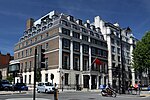Devonshire Close

Devonshire Close, originally known as Devonshire Mews East, is a mews street in the City of Westminster, London, accessed from Devonshire Street. The Close is on a distinctive H plan with a middle downwards leg. It dates from the 1770s and originally contained a timber yard, stables, and accommodation for domestic servants who worked in the larger houses surrounding it. Access was limited to the north side in order to divert traffic from the grander north–south streets around it. The Close was gentrified in the 20th century and its buildings converted to mews houses which, like other mews in London, have become desirable in the modern era because they are quiet and have little traffic. The Close is now part of the Howard de Walden Estate.
Excerpt from the Wikipedia article Devonshire Close (License: CC BY-SA 3.0, Authors, Images).Devonshire Close
Devonshire Close, City of Westminster Marylebone
Geographical coordinates (GPS) Address Nearby Places Show on map
Geographical coordinates (GPS)
| Latitude | Longitude |
|---|---|
| N 51.5214 ° | E -0.147 ° |
Address
Devonshire Close 17
W1G 7AX City of Westminster, Marylebone
England, United Kingdom
Open on Google Maps










